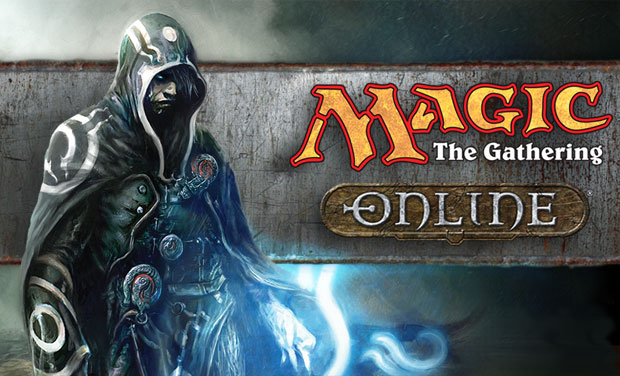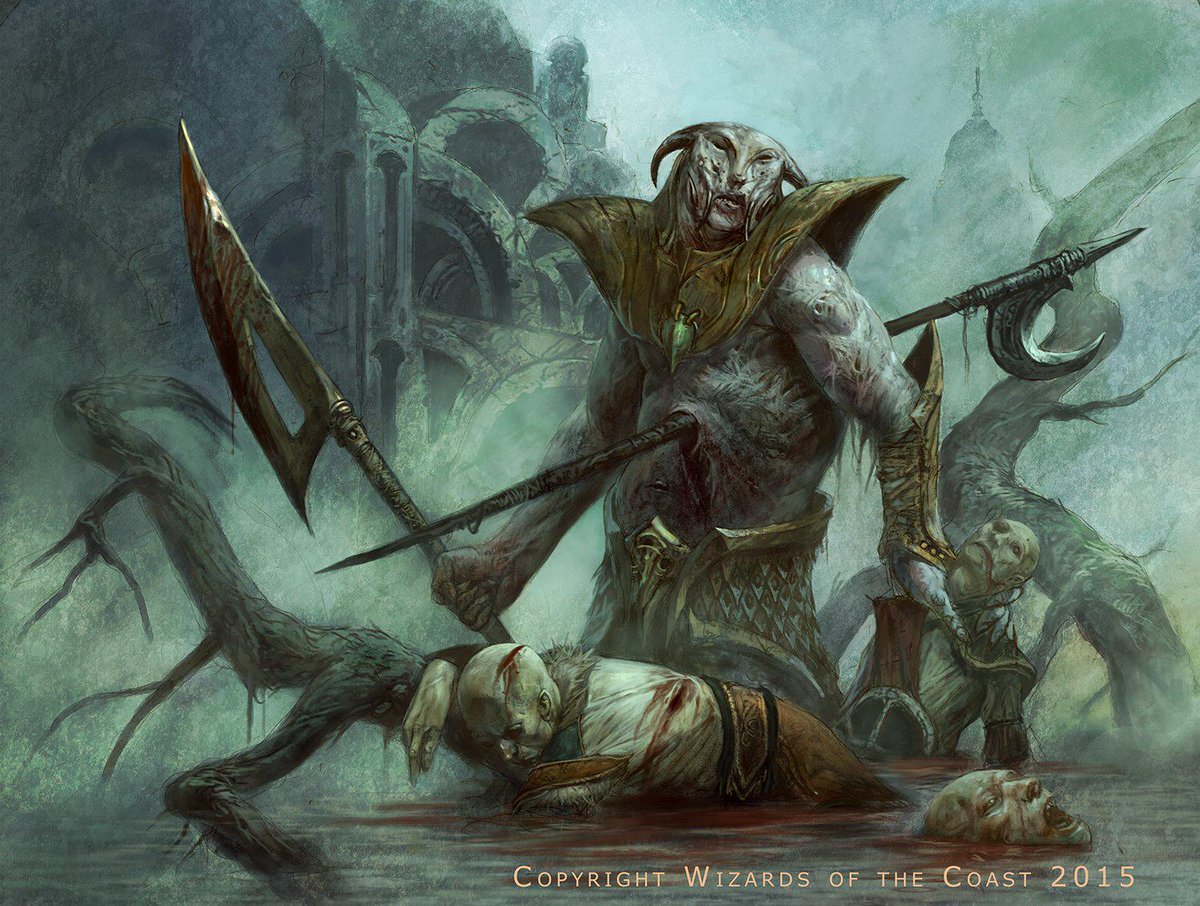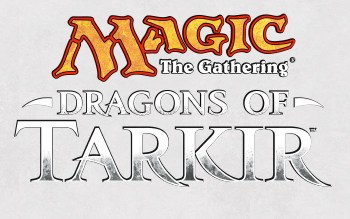Monday was fairly eventful (get it, event-full?) for MPDC 29.03, our weekly Standard Pauper Player Run Event. So I thought I would take some time today to talk about what happened.
First of all, after averaging somewhere around 15 players per event, we had 22 players, which is almost enough to get us back to 4 rounds of Swiss plus Top 8. Among them we were fortunate enough to have Jason Moore, who goes by the username BambooRush, join us for the event. In case you don't know, Jason is a regular contributor over at MTGOAcademy on the Pauper format and part of the Pauper's Cage Podcast. In fact, Jason was recording all of his matches, which you can check out here. We were also joined by one totalhate, another well known Pauper player.
Second, based on the surge in attendance, I made the decision that every week in which we have at least 18 players for MPDC, I will give away a single Dragons of Tarkir booster to one random player. All you have to do is play in all of the Swiss rounds, and you'll automatically be entered into the giveaway. Where else can you get value like that?
Finally, I also managed to take 2nd place with a Green "Formidable" deck (based on Gq1rf7's list of the same name) splashing Blue for Anticipate and Treasure Cruise that I called Wintergreen. I am working on an article for PureMTGO covering the deck, but I was also fortunate enough to have the deck mentioned on the latest episode of the MagicGatheringStrat Show, which I encourage you to check out.
Like I said, it was an eventful day for MPDC. Hopefully it's a sign of even better days to come!
Thursday, April 30, 2015
Tuesday, April 28, 2015
Standard Pauper PRE Data Analysis
As part of my recent project to survey information from our players on the two Standard Pauper Player Run Events that are run each and every week through pdcmagic.com, I have been analyzing data from this year's attendance at both Monday Pauper Deck Challenge and Standard Pauper Deck Challenge. My hope is that after I've had the chance to sort through all this data and talk with individuals within the community that we will be able to make whatever changes need to be made to better support Standard Pauper going forward.
Let's take a look at my analysis from the data from MPDC and SPDC:
Here's my take on this data:
Let's take a look at my analysis from the data from MPDC and SPDC:
 | ||||
| Click on the above image to enlarge it. |
- Over just 29 events, we've had 96 unique players participate in one of our events. Of those, about ten percent have participated regularly, with another 15 percent playing occasionally. We're actually attracting a fair amount of new players, given that this spans only four months of time.
- Unfortunately, of the 96 unique players, a full 43 of them have only participated once. While my data doesn't account for new players who have stuck around, it's still fair to say that we have a retention problem. The majority of newcomers don't stick around to play more than once.
- Of the players who have participated in at least 5 events, only 4 of those only play in either MPDC and SPDC. The other 21 have played at least once in both MPDC and SPDC, although most show a decided preference for one event or the other (although this isn't represented in the graphic above).
- MPDC has a higher overall attendance, which makes sense given that it's been running at that time slot and day for a whole lot longer than SPDC has been at its current day and time.
Saturday, April 25, 2015
Standard Pauper PRE Survey Follow-Up, Part Two
The survey that I've been blogging about all week continues to get results. Last time, I discussed the fact that a surprising number of my readers had no idea that our Standard Pauper Player Run Events even existed. While that result was surprising, it's not even close to the most common response. Instead, far and away the response chosen time and time again is that the current events don't fit players' schedules. So today, I want to request more data. Specifically, I like to know what time and/or days of the week would be better than what we're current running. For reference, we're currently utilizing Sundays and Mondays, both at 2pm EDT / 6pm GMT.
So here's the follow-up survey:
So here's the follow-up survey:
When would be the best time for you to participate in a Standard Pauper Event?
I prefer the current day(s) and time slot (Sun & Mon, 2pm EST / 6pm GMT) 0%
0%
 0%
0%
The current day(s) work fine for me, but I would prefer a different time (indicate time in GMT below) 0%
0%
 0%
0%
The current time works fine for me, but it needs to be a different day (indicate day below) 0%
0%
 0%
0%
The problem's not the day and time; I just can't show up for 3+ hours to play 0%
0%
 0%
0%
My preferred day/time:  0%
0%
 0%
0%Thursday, April 23, 2015
Standard Pauper PRE Survey Follow-Up, Part One
Thanks so much to everyone who has taken the time to respond to the survey I put out earlier this week. Thanks too to Chris Baker, rremedio1, bava, and others who took the time to retweet and/or post links to the survey.
While I'm certainly not closing the survey yet, two answers have stood out to me clearly. First, of the 40 responses so far, 7 of those have indicated that they were unaware that Standard Pauper Player Run Events even exist. So let's clear that up:
Every Sunday DrChrisBakerDC and/or rremedio1 run an event called Standard Pauper Deck Challenge (SPDC) at 2pm EDT / 6pm GMT on Magic Online. To register, browse over to pdcmagic.com, click on Gatherling, login to your Player CP, and click the link under "PREREGISTER FOR EVENTS." Pairings, Results, and Standings are all available through your Player CP.
Every Monday, I run an event called Monday Pauper Deck Challenge (MPDC) at 2pm EDT / 6pm GMT on Magic Online. To register, login to Magic Online between 2-2:30pm, open up chat channel #mpdc and #mpdccom, and type "REG" in the #mpdccom channel. Pairings, Results, and Standings are available through the Standard forums over at pdcmagic.com.
You can also find all of the rules, prize information, tournament structure, and more in the MPDC Season Document, which is updated each time a new set enters Standard. Gatherling on pdcmagic.com is also a great resource to view the current state of the metagame. Just click the "See a list of recent events" link and look for SPDC and MPDC to see the winning decklists from each event.
So, enough about that. Let's talk about the most common response from the survey. The most common response from the survey so far indicates that the current time and day(s) of the week during which the tournament is being held doesn't work. Next time, I will have a follow-up survey to help gather some more data towards that end.
While I'm certainly not closing the survey yet, two answers have stood out to me clearly. First, of the 40 responses so far, 7 of those have indicated that they were unaware that Standard Pauper Player Run Events even exist. So let's clear that up:
Every Sunday DrChrisBakerDC and/or rremedio1 run an event called Standard Pauper Deck Challenge (SPDC) at 2pm EDT / 6pm GMT on Magic Online. To register, browse over to pdcmagic.com, click on Gatherling, login to your Player CP, and click the link under "PREREGISTER FOR EVENTS." Pairings, Results, and Standings are all available through your Player CP.
Every Monday, I run an event called Monday Pauper Deck Challenge (MPDC) at 2pm EDT / 6pm GMT on Magic Online. To register, login to Magic Online between 2-2:30pm, open up chat channel #mpdc and #mpdccom, and type "REG" in the #mpdccom channel. Pairings, Results, and Standings are available through the Standard forums over at pdcmagic.com.
You can also find all of the rules, prize information, tournament structure, and more in the MPDC Season Document, which is updated each time a new set enters Standard. Gatherling on pdcmagic.com is also a great resource to view the current state of the metagame. Just click the "See a list of recent events" link and look for SPDC and MPDC to see the winning decklists from each event.
So, enough about that. Let's talk about the most common response from the survey. The most common response from the survey so far indicates that the current time and day(s) of the week during which the tournament is being held doesn't work. Next time, I will have a follow-up survey to help gather some more data towards that end.
Tuesday, April 21, 2015
Standard Pauper PRE Survey
Please note that there is now a follow-up survey in addition to this one regarding specific times and days of the week for our events. If you have a moment, please click here and let your voice be heard!
Earlier this week, I was discussing with Chris Baker the current state of the two Player Run Events we run. These are free Standard Pauper tournaments, with over $40 a week in prizes going to the winners each and every week. Once upon a time, it wasn't unusual for us to see over 60 unique players in a week; now, we're lucky if we get a quarter of that. The question is, why?
So I am asking you, my loyal readers, to participate in a short poll. Given the views on this blog, I know only a small percentage of you regularly participate in our weekly events. For the rest of you, I have a simple question I would like you to answer: Why don't you participate in our events? Or, if you do sometimes participate, what keeps you from participating more?
Earlier this week, I was discussing with Chris Baker the current state of the two Player Run Events we run. These are free Standard Pauper tournaments, with over $40 a week in prizes going to the winners each and every week. Once upon a time, it wasn't unusual for us to see over 60 unique players in a week; now, we're lucky if we get a quarter of that. The question is, why?
So I am asking you, my loyal readers, to participate in a short poll. Given the views on this blog, I know only a small percentage of you regularly participate in our weekly events. For the rest of you, I have a simple question I would like you to answer: Why don't you participate in our events? Or, if you do sometimes participate, what keeps you from participating more?
Why don't you participate (more) in the weekly free Standard Pauper events?
There are weekly tournaments? Never heard of them... 0%
0%
 0%
0%
I'd play, but they just don't fit my schedule. 0%
0%
 0%
0%
Sorry, but I'm just not interested in the format. 0%
0%
 0%
0%
I hate the Magic Online client and refuse to use it. 0%
0%
 0%
0%
I'm just starting out, and I don't feel like I'm good enough to compete. 0%
0%
 0%
0%
I don't like the host(s) and/or the players. 0%
0%
 0%
0%
I play every week; don't look at me! 0%
0%
 0%
0%
Other: (Please specify) 0%
0%
 0%
0%Sunday, April 19, 2015
Infinite Life in Standard Pauper
All week I've been blogging about the new combos in Standard Pauper and how you as a player need to be prepared to answer them. Today I want to look at another fun trick you can do with one of the combos that I haven't seen anyone mention yet.
For review, the first combo involves playing and replaying Spidersilk Net by means of Zephyr Scribe enchanted with Retraction Helix. In this scenario, the accepted wisdom is to use this combination to power up your Elusive Spellfist until it can deal lethal damage to your opponent.
However, something fun happens when you replace the Spellfist with this card:
Student of Ojutai harkens back to the Gatekeepers cycle from Dragon's Maze. It's a 2/4 for 3W that is pretty decent on its own, given its potential to gain you quite a bit of life in the right build while also presenting a fairly relevant blocker. But combine this with the above combination, and you have created a loop that can generate an infinite amount of life, assuming your opponent doesn't have any means to interact with you. I believe that this is the first time that this is possible in Standard Pauper (although if I'm wrong, please let me know in the comments below).
So why hasn't this combo gotten any attention?
Well, there's just one small problem with gaining infinite life: it doesn't actually win you the game. In fact, it's even worse online than it would be in paper, since the presence of the game clock means that even if your opponent can't ever actually kill you, all he or she actually has to do is either be ahead on time or on cards to win (since you lose either when your game clock runs out of time or you are unable to draw your last card). And since Standard Pauper lacks any means of shuffling your library back into your deck, this probably isn't really a viable win condition.
That said, someone might be able to make a deck designed to pull this combo off, then Gravepurge another creatures back into your library to avoid losing my running out your library. Then all you'd have to worry about is being ahead on time. Not exactly the kind of deck I'd want to run, especially since it requires three colors of mana - but hey, it might actually be feasible!
So that's another fun thing you can pull off with this combo.
For review, the first combo involves playing and replaying Spidersilk Net by means of Zephyr Scribe enchanted with Retraction Helix. In this scenario, the accepted wisdom is to use this combination to power up your Elusive Spellfist until it can deal lethal damage to your opponent.
However, something fun happens when you replace the Spellfist with this card:
Student of Ojutai harkens back to the Gatekeepers cycle from Dragon's Maze. It's a 2/4 for 3W that is pretty decent on its own, given its potential to gain you quite a bit of life in the right build while also presenting a fairly relevant blocker. But combine this with the above combination, and you have created a loop that can generate an infinite amount of life, assuming your opponent doesn't have any means to interact with you. I believe that this is the first time that this is possible in Standard Pauper (although if I'm wrong, please let me know in the comments below).
So why hasn't this combo gotten any attention?
Well, there's just one small problem with gaining infinite life: it doesn't actually win you the game. In fact, it's even worse online than it would be in paper, since the presence of the game clock means that even if your opponent can't ever actually kill you, all he or she actually has to do is either be ahead on time or on cards to win (since you lose either when your game clock runs out of time or you are unable to draw your last card). And since Standard Pauper lacks any means of shuffling your library back into your deck, this probably isn't really a viable win condition.
That said, someone might be able to make a deck designed to pull this combo off, then Gravepurge another creatures back into your library to avoid losing my running out your library. Then all you'd have to worry about is being ahead on time. Not exactly the kind of deck I'd want to run, especially since it requires three colors of mana - but hey, it might actually be feasible!
So that's another fun thing you can pull off with this combo.
Thursday, April 16, 2015
Answering Combo in Standard Pauper
Last time, I wrote about the new combos in Standard Pauper. It seems like the whole community is buzzing about it. It's on Twitter, showing up in articles, and making appearances in the weekly PREs and practice matches. So you better be prepared to play against it, even if you've jumped on the bandwagon and are playing it yourself. Fortunately, as DrChrisBakerDC put it, the combos are quite fragile.
It's important to remember that the combo actually relies on three different cards to activate, and a fourth card for either combo to actually do anything. This means your opponent will need time to assemble these pieces, and you have multiple avenues of attack. But at its heart, both combos are reliant on untapping a single creature. Which means you can answer the combo by:
1. Taking out the creature. Point your removal of choice at Midnight Guard or Zephyr Scribe, and when it fits the Graveyard, the combo is dead in the water. The Scribe is particularly fragile with only 1 Toughness, but you'll need something a bit more potent to take out the Guard. Unfortunately, there's a wealth of ways to protect creatures - Gods Willing and its variants primarily, but also Glint, which is seeing play right alongside the Zephyr combo. Which means you might want to try...
2. Using counter magic. Counter either creature before it enters the virtual battlefield, or counter whatever spell your opponent uses to protect it. Cancel is probably the best, but Negate and Nullify are also worth considering. Of course, this forces you to hold up mana over multiple turns. Which means the better solution might be...
3. Removing the combo pieces before they're cast. Black has a whole suite of discard effects now, including the newly reprinted Duress, which not only lets you see exactly what your opponent has in hand, but also take out any of the non-creature cards or protection spells. But any of these first three options are better than...
4. Using specific hate cards against the Artifact. Both combos rely upon a mediocre Artifact to combo off, and you could certainly include cards like Naturalize or Shatter to destroy them. The biggest problem with this option, however, is that these cards don't have a lot of good targets in the format right now, and so might be a bit too narrow to include.
So while these two new combinations are both popular and fun, they are most dangerous when people aren't prepared for them. But forewarned is forearmed, as the saying goes. Don't let these combos get you down. Stop them in their tracks!
It's important to remember that the combo actually relies on three different cards to activate, and a fourth card for either combo to actually do anything. This means your opponent will need time to assemble these pieces, and you have multiple avenues of attack. But at its heart, both combos are reliant on untapping a single creature. Which means you can answer the combo by:
1. Taking out the creature. Point your removal of choice at Midnight Guard or Zephyr Scribe, and when it fits the Graveyard, the combo is dead in the water. The Scribe is particularly fragile with only 1 Toughness, but you'll need something a bit more potent to take out the Guard. Unfortunately, there's a wealth of ways to protect creatures - Gods Willing and its variants primarily, but also Glint, which is seeing play right alongside the Zephyr combo. Which means you might want to try...
2. Using counter magic. Counter either creature before it enters the virtual battlefield, or counter whatever spell your opponent uses to protect it. Cancel is probably the best, but Negate and Nullify are also worth considering. Of course, this forces you to hold up mana over multiple turns. Which means the better solution might be...
3. Removing the combo pieces before they're cast. Black has a whole suite of discard effects now, including the newly reprinted Duress, which not only lets you see exactly what your opponent has in hand, but also take out any of the non-creature cards or protection spells. But any of these first three options are better than...
4. Using specific hate cards against the Artifact. Both combos rely upon a mediocre Artifact to combo off, and you could certainly include cards like Naturalize or Shatter to destroy them. The biggest problem with this option, however, is that these cards don't have a lot of good targets in the format right now, and so might be a bit too narrow to include.
So while these two new combinations are both popular and fun, they are most dangerous when people aren't prepared for them. But forewarned is forearmed, as the saying goes. Don't let these combos get you down. Stop them in their tracks!
Tuesday, April 14, 2015
Combo in Standard Pauper
Suddenly I don't recognize Standard Pauper at all.
Well, that's not entirely true. But despite all the careful attention I paid to the new cards from Dragons of Tarkir, I failed to recognize that the addition of just three cards into the format unleashed not one but two potentially viable "infinite" combos onto the metagame. It wasn't until I saw this post by rremedio1 that I understood what I had overlooked.
Both combos are remarkably similar, relying upon a zero cost spell plus a creature than untaps when a certain requirement is met:
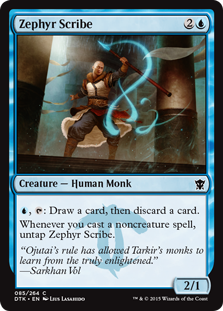

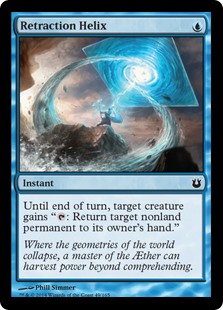

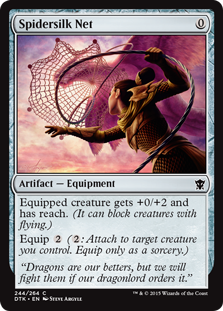
For this first combo, you cast the Helix on the Zephyr Scribe, then use the newly granted ability to bounce the Net back into your hand. Then, you cast the Spidersilk Net again for free. Since this is a noncreature spell, it activates the untap secondary ability on the Scribe, untapping it. You can then repeat this indefinitely (assuming your opponent doesn't interact to stop you).
To take advantage of this interaction, all you need is something that generates an effect as often as a noncreature spell is cast. Any Prowess creature will do the trick, but Elusive Spellfist is particularly effective, since it cannot be blocked. You simply repeat the combo until the creature has enough Power to deal lethal damage and then attack with it.
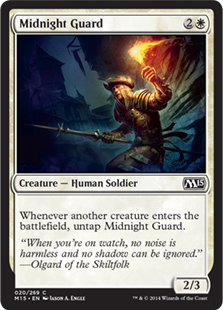



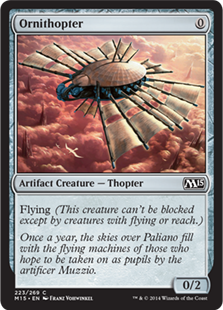
The second combo also utilizes Retraction Helix, but relies upon a different creature with an untap ability. Midnight Guard untaps whenever another creature enters the battlefield. So you use the Helix to bounce the Ornithopter, then replay it for free. Since this is a creature, it triggers the untap ability of the Midnight Guard, untapping it to allow you to again repeat this as many times as you want.
To take advantage of this interaction, you need something that generates an effect whenever a creature enters the battlefield. In this case, Impact Tremors fits the bill, since it deals one damage whenever a creature enters the battlefield under your control. Repeat the combo as many times as it takes to deal lethal damage to your opponent.
Next time, I'll talk more about these two combinations and what you can do to combat them.
Well, that's not entirely true. But despite all the careful attention I paid to the new cards from Dragons of Tarkir, I failed to recognize that the addition of just three cards into the format unleashed not one but two potentially viable "infinite" combos onto the metagame. It wasn't until I saw this post by rremedio1 that I understood what I had overlooked.
Both combos are remarkably similar, relying upon a zero cost spell plus a creature than untaps when a certain requirement is met:
For this first combo, you cast the Helix on the Zephyr Scribe, then use the newly granted ability to bounce the Net back into your hand. Then, you cast the Spidersilk Net again for free. Since this is a noncreature spell, it activates the untap secondary ability on the Scribe, untapping it. You can then repeat this indefinitely (assuming your opponent doesn't interact to stop you).
To take advantage of this interaction, all you need is something that generates an effect as often as a noncreature spell is cast. Any Prowess creature will do the trick, but Elusive Spellfist is particularly effective, since it cannot be blocked. You simply repeat the combo until the creature has enough Power to deal lethal damage and then attack with it.
The second combo also utilizes Retraction Helix, but relies upon a different creature with an untap ability. Midnight Guard untaps whenever another creature enters the battlefield. So you use the Helix to bounce the Ornithopter, then replay it for free. Since this is a creature, it triggers the untap ability of the Midnight Guard, untapping it to allow you to again repeat this as many times as you want.
To take advantage of this interaction, you need something that generates an effect whenever a creature enters the battlefield. In this case, Impact Tremors fits the bill, since it deals one damage whenever a creature enters the battlefield under your control. Repeat the combo as many times as it takes to deal lethal damage to your opponent.
Next time, I'll talk more about these two combinations and what you can do to combat them.
Saturday, April 11, 2015
UB Exploit
During the spoiler season for Dragons of Tarkir, I wrote several posts regarding the new mechanic Exploit for the set. Now, with all the cards at my disposal on Magic Online, a Blue/Black Exploit deck is definitely the first build I want to experiment with. UB Control was already a pretty strong deck in the metagame, although it relied more on the synergy built around Black Devotion, and particularly Gray Merchant of Asphodel, to power out its wins. With the Exploit Commons fairly evenly split between Black and Blue, it turns out that utilizing that same synergy will be much more difficult.
Here's the current build that I am testing:
Essentially I am running cheap creatures to sacrifice with Exploit, including the excellent Pharika's Chosen for early defense, and both Palace Familiar and Jeskai Sage, which draw you a card when they die. Additionally, between Exploit in general and Gurmag Drowner in particular, you should be quickly filling up your Graveyard, creating easy fuel for Treasure Cruise and Sultai Scavenger. This also allows the deck to quickly draw through its cards, especially utilizing Anticipate and the excellent Vulturous Aven. This build is definitely light on removal, with only three Whisk Away in the main deck, supplemented with two copies of Silumgar Butcher. Finally, I added a few "silver-bullets" with Benthic Giant, Eternal Thirst, Font of Return, and Servant of Tyramet.
I have a few questions I'm still trying to answer:
Here's the current build that I am testing:
UB Exploit
by gwyned
| Creatures 4 Palace Familiar 4 Pharika's Chosen 4 Vulturous Aven 3 Jeskai Sage 3 Sultai Scavenger 2 Gurmag Drowner 2 Silumgar Butcher 1 Benthic Giant 1 Servant of Tymaret 24 cards Other Spells 4 Anticipate 4 Treasure Cruise 3 Whisk Away 1 Eternal Thirst 1 Font of Return 13 cards |
Lands 4 Dismal Backwater 4 Evolving Wilds 7 Swamp 8 Island 23 cards
Sideboard
3 Duress 3 Festergloom 3 Pharika's Cure 2 Negate 2 Returned Phalanx 1 Benthic Giant 1 Flesh to Dust 15 cards |
Essentially I am running cheap creatures to sacrifice with Exploit, including the excellent Pharika's Chosen for early defense, and both Palace Familiar and Jeskai Sage, which draw you a card when they die. Additionally, between Exploit in general and Gurmag Drowner in particular, you should be quickly filling up your Graveyard, creating easy fuel for Treasure Cruise and Sultai Scavenger. This also allows the deck to quickly draw through its cards, especially utilizing Anticipate and the excellent Vulturous Aven. This build is definitely light on removal, with only three Whisk Away in the main deck, supplemented with two copies of Silumgar Butcher. Finally, I added a few "silver-bullets" with Benthic Giant, Eternal Thirst, Font of Return, and Servant of Tyramet.
I have a few questions I'm still trying to answer:
- Is this the right mix of Exploit creatures to play?
- Is it a mistake to not run enough Black creatures to make Gray Merchant viable?
- Can the deck get away with so little removal?
Thursday, April 9, 2015
How To Get Your Writing Noticed
As any of my longtime readers should know, I am a tireless enthusiast for the Standard Pauper format on Magic Online. In the past, I have encouraged anyone with the ability to write to create content to bring further attention to the format.
So today, I came across an excellent article by Pauper expert Alex Ullman, who writes for both PureMTGO and GatheringMagic, entitled "Making Headlines." I would encourage everyone to go check out the whole article if you have any interest at all in creating content about Magic, Magic Online, Standard Pauper, or the like. But I also want to share with you some of the highlights from his article.
So how do you get your writing noticed?
1. You have to write. This seems pretty intuitive, but you'd be surprised how often this first step is neglected. The Internet is the great equalizer. Find a place and start collecting your thoughts and ideas.
2. You need to publish consistently. Ullman correctly recognizes that consistency is usually more important than quality. Yes, you want to craft the best writing that you can. But if you want to get noticed, it's important that you write on a consistent schedule.
3. You need to leverage your network. So as you begin to consistently create content, you need to find ways of bringing it to your audience without being obnoxious about it. Find your niche, ask your friends to promote your writing, and utilize social media to let people you already associate with discover your writing.
Do these three things, do them consistently over time, and you will grow your audience, improve your craft, and begin to carve out for yourself an audience. It's not magic, it's not luck, and it's not determined by some whim of fate. Go check out Ullman's article and read his story for yourself.
So what are you waiting for? Pick up your (virtual) pen and get to work!
So today, I came across an excellent article by Pauper expert Alex Ullman, who writes for both PureMTGO and GatheringMagic, entitled "Making Headlines." I would encourage everyone to go check out the whole article if you have any interest at all in creating content about Magic, Magic Online, Standard Pauper, or the like. But I also want to share with you some of the highlights from his article.
So how do you get your writing noticed?
1. You have to write. This seems pretty intuitive, but you'd be surprised how often this first step is neglected. The Internet is the great equalizer. Find a place and start collecting your thoughts and ideas.
2. You need to publish consistently. Ullman correctly recognizes that consistency is usually more important than quality. Yes, you want to craft the best writing that you can. But if you want to get noticed, it's important that you write on a consistent schedule.
3. You need to leverage your network. So as you begin to consistently create content, you need to find ways of bringing it to your audience without being obnoxious about it. Find your niche, ask your friends to promote your writing, and utilize social media to let people you already associate with discover your writing.
Do these three things, do them consistently over time, and you will grow your audience, improve your craft, and begin to carve out for yourself an audience. It's not magic, it's not luck, and it's not determined by some whim of fate. Go check out Ullman's article and read his story for yourself.
So what are you waiting for? Pick up your (virtual) pen and get to work!
Wednesday, April 8, 2015
Kingdom Builder
Sorry this is late. I am traveling and I have a very spotty Internet connection. As a result, I was unable to actually upload this post until Wednesday.
Kingdom Builder is a strategy game published by Queen Games themed around the concept creating your own kingdom by strategically placing settlements across the region, taking control of key areas and earning the most gold at the end of the game.
is a strategy game published by Queen Games themed around the concept creating your own kingdom by strategically placing settlements across the region, taking control of key areas and earning the most gold at the end of the game.
The strengths of this game are its simplicity, its strategic depths, and its replayability. Each game you randomly create the game board by combining four of the eight hex boards, which vary not only in the arrangement of the different terrain tiles but also in the key locations that will be available to the players. You also randomly select three of the ten Kingdom Builder cards, which detail the way that gold is earned at the end of the game. These two elements ensure that each game will be quite different than the one before, giving Kingdom Builder its high replay value.
Each turn, you place three settlements on the terrain that matches the terrain card you drew, and then may place bonus settlements based on the key locations that you control. Your settlements normally must be placed adjacent to your other settlements if possible, although there are several different ways of sidestepping that rule - either by not having a valid adjacent location or by utilizing the special abilities of your key locations. Once the first player has placed all of his or her settlements, each other player gets one more turn, and then the game is over. It's fairly easy to explain to new players, but the strategic depth of each turn is deceptively deep.
Overall I definitely enjoy this game. The production values are high, the components are well made, and it's an enjoyable strategic exercise without feeling overwhelming. The base game is designed for 2-4 players, but it does include a single player variant, and an expansion to add the ability to play with up to 6 is also available. Two minor quibbles, however: first, the fantasy "kingdom builder" theme is mostly just window dressing and doesn't really impact the gameplay; second, the rules have obviously been translated into English from another language, and are not always as clear on first read as I would have liked.
Nonetheless, Kingdom Builder is a great game, and one I definitely recommend you try.
is a great game, and one I definitely recommend you try.
Kingdom Builder
The strengths of this game are its simplicity, its strategic depths, and its replayability. Each game you randomly create the game board by combining four of the eight hex boards, which vary not only in the arrangement of the different terrain tiles but also in the key locations that will be available to the players. You also randomly select three of the ten Kingdom Builder cards, which detail the way that gold is earned at the end of the game. These two elements ensure that each game will be quite different than the one before, giving Kingdom Builder its high replay value.
Each turn, you place three settlements on the terrain that matches the terrain card you drew, and then may place bonus settlements based on the key locations that you control. Your settlements normally must be placed adjacent to your other settlements if possible, although there are several different ways of sidestepping that rule - either by not having a valid adjacent location or by utilizing the special abilities of your key locations. Once the first player has placed all of his or her settlements, each other player gets one more turn, and then the game is over. It's fairly easy to explain to new players, but the strategic depth of each turn is deceptively deep.
Overall I definitely enjoy this game. The production values are high, the components are well made, and it's an enjoyable strategic exercise without feeling overwhelming. The base game is designed for 2-4 players, but it does include a single player variant, and an expansion to add the ability to play with up to 6 is also available. Two minor quibbles, however: first, the fantasy "kingdom builder" theme is mostly just window dressing and doesn't really impact the gameplay; second, the rules have obviously been translated into English from another language, and are not always as clear on first read as I would have liked.
Nonetheless, Kingdom Builder
Saturday, April 4, 2015
Tokens with Dragons of Tarkir
As I'm finishing off Part 3 of my Standard Pauper review of Dragons of Tarkir, two cards have really stood out to me as really pushing you to play a dedicated Tokens build. With Dragons of Tarkir, we have 13 cards that generate tokens, primarily focused in both Red and White. Generally speaking, for a Tokens build, you want cheap spells that generate multiple creatures, of which five really stand out: Dragon Fodder, Mardu Hordechief, Raise the Alarm, Sandsteppe Outcast, and Triplicate Spirits. That's a pretty decent set of cards. So what's our incentive?
1. Foul-Tongue Shriek looks like a really strong card. It's cheap, Instant speed, and even with only 3 creatures, you're getting a six point life swing, which certainly is significant in almost any game state. But the real problem with this card is that it has no actual effect on the board itself, and does absolutely nothing unless you have creatures with good attacks in the first place. This obviously seems perfect for such a tokens strategy, but requires you to splash for Black in order to cast it. In the right scenario, this card could be amazing. But what about the rest of the time? Does this give you a good enough payoff to be worth playing?
2. Impact Tremors is the other card clearly designed to synergize with token strategies. If you take Lightning Strike as a baseline, it takes a minimum of three activations to at least get an equivalent amount of damage. Worse though, the damage can only be used on your opponent, not on opposing creatures. There certainly seem to be enough token generators to get some value out of this, but it remains to be seen whether its enough to really make this worthwhile. There's a ton of value to be had in the right deck in the right circumstances; but again, is the average payoff good enough to be worth playing even in a dedicated token strategy?
To be honest, I have my doubts. What do you think?
1. Foul-Tongue Shriek looks like a really strong card. It's cheap, Instant speed, and even with only 3 creatures, you're getting a six point life swing, which certainly is significant in almost any game state. But the real problem with this card is that it has no actual effect on the board itself, and does absolutely nothing unless you have creatures with good attacks in the first place. This obviously seems perfect for such a tokens strategy, but requires you to splash for Black in order to cast it. In the right scenario, this card could be amazing. But what about the rest of the time? Does this give you a good enough payoff to be worth playing?
2. Impact Tremors is the other card clearly designed to synergize with token strategies. If you take Lightning Strike as a baseline, it takes a minimum of three activations to at least get an equivalent amount of damage. Worse though, the damage can only be used on your opponent, not on opposing creatures. There certainly seem to be enough token generators to get some value out of this, but it remains to be seen whether its enough to really make this worthwhile. There's a ton of value to be had in the right deck in the right circumstances; but again, is the average payoff good enough to be worth playing even in a dedicated token strategy?
To be honest, I have my doubts. What do you think?
Subscribe to:
Posts (Atom)

